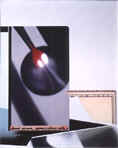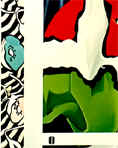H. Avni Öztopcu's
"Road of
Place" In his early works
(1985), he used black which he defined as "darkness" and
white which he defined as "light" as his basic tools.
 1985
Büyük Oylum
1985
Büyük Oylum
We
see that he tried to reinforce the geometric speculative integrity
of the stratified contrasts created by lighted crystal brightness of
the mechanical objects which he places inside the dark spaces with
their grayish-white gradations, together with diagonal planes
including amorphous motives with elements of connections, motion,
repetition and texture. In his later works (1986),
 1986
Meşale
1986
Meşale
while contrast
created by motion in the earlier stages where being replaced by
perpendicular and horizantal forms in conrast, rythmic elements
making the geometric planes of mechanical objects took the place of
contrast forms (Amorphous-Crystal). Grades of grayish-white
transformed into grades of colour. The rythmic elements of
repetition prevail their mechical structure while in search of their
appropriate place and function. It is not difficult to see that the
reason for this change in H. Avni Oztopcu's paintings is connected
with his orientation towards
 1986
Yapraklar
1986
Yapraklar
"colour" and "motives"
which gained significance in his works. In fact in his later works
(1987) these two elements constitute the fundamental structure upon
which he builts his drawings. The function of the black and white
contrast in his early works are now transformed into the function of
colour contrasts. His passion for black and white contrast has been
transformed into grayish spaces and passages which he used in his
drawings.
 1987
Tütün Çiçeği
1987
Tütün Çiçeği
While mechanical decorations take the form of organic textures, "Planimetric" structure has been adopted with
respect to space as a result of this approach.
 1988 -1989, sütunlar
1988 -1989, sütunlar
opinions
- letters 